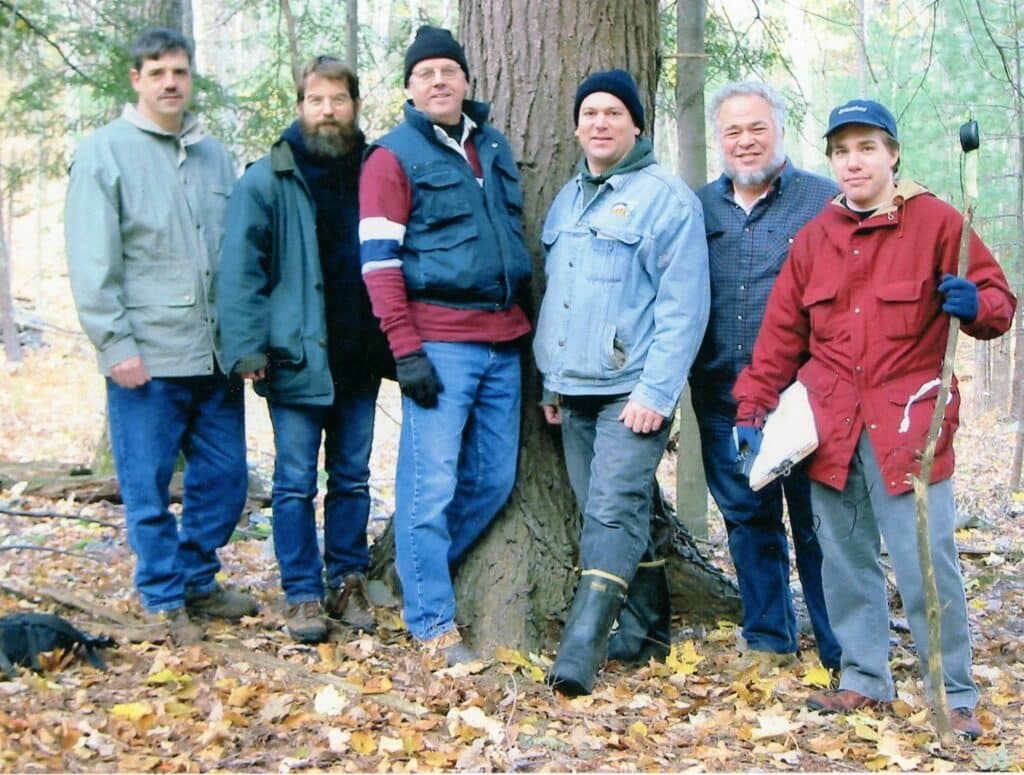Forestry Stewardship
Forest History
Camp Deerpark was founded in 1969 when the New York City Mennonite churches purchased the Winkler’s Country Club, which was previously owned by the George Brandt family. In the mid 1970s some logging was done at Camp Deerpark in the Orange Trail area on the south side of Brandt Road. Unfortunately, at that time the general consensus among the constituency was that the logging was far too aggressive and that it had left the forest with unacceptable damage.
The idea of logging at Camp Deerpark was again raised in the summer of 1996 when Dennis Sharp, the father-in-law of Ken Bontrager, suggested that the Camp Deerpark woods was full of adult trees ripe for harvest. When Ken Bontrager brought the idea to the camp board they wisely turned it down, citing the destruction caused by the 1970s logging. In the fall of 1997 when the North Bronx Mennonite Church held their church retreat, Wayne and Annie Shreffler invited their neighbors, Chuck and Elysa Hammond Peters. That weekend Dr. Chuck Peters of the New York Botanical Garden had an opportunity to hike in the woods at Camp Deerpark. Chuck and Ken began to talk about a forestry program that evening over coffee and pumpkin pie. Chuck introduced the principal of sustained-yield forestry, which received complete support from the board.

From the spring of 1998 to the summer of 2000, volunteers and staff conducted a ten percent inventory of all forestland on the property, identified and marked all property lines, produced a map marking trails and roads, and with thanks to Kevin Coffey, a research assistant at the New York Botanical Garden, combined all the information in a data base.
What is Sustained Yield Forestry?
With detailed counting and measuring of trees, one can calculate the stock and annual growth of a given tract of forest. If a logging program only harvests the annual growth each year and leaves the stock intact, the forest will maintain itself and continue growing vigorously. A good analogy is that of a financial investment. One can spend the interest annually, but must take care to not diminish the principal. Sustained-yield forestry strives to harvest the interest (i.e. the growth) while safeguarding the principal (i.e. the growing stock). Unlike a financial investment, however, a forest management program continually increases the growth and health of the overall forest. The oldest and largest trees are harvested first because they are most susceptible to disease, and they have large crowns that suppress the growth of smaller trees.
What Did the Inventory Tell Us?
While there are more than twenty-five species of trees on the 277 acres at camp, there are four primary species: white pine, red oak, chestnut oak, and white oak. The inventory revealed 6000 merchantable trees. (A merchantable tree is one that has value at a local sawmill and generally required to be14 inches in diameter, 16 feet tall, and straight.) The 1998–2000 inventory and subsequent calculations informed us our forest was growing at a rate of 29,000 board feet per year. A board foot is measured by a piece of wood 12 inches by 12 inches by one inch thick. The typical white pine tree contains approximately 160 board feet. Ben Cheek estimates 40–45 white pine trees are required to build one Promise Woods cabin. From 2002 through 2012 Camp Deerpark harvested 259,482 board feet, approximately 1600 trees, from our property. Remember we started with 6000 merchantable trees. Here is the exciting news. After 10 years of careful stewardship, harvesting approximately 1600 trees, and building four Promise Woods cabins; the 2012 inventory revealed that the Camp Deerpark forest is now growing at a rate of 45,000 board feet per year. The forest is younger, stronger, straighter, well balanced, and ready to serve our children and grandchildren. As Anabaptist Christians we believe that God has blessed us with this beautiful land and our responsibility is to do our best to be good stewards of this gift. The Camp Deerpark board and administration is grateful for the many volunteers who have helped us care for our woods.
—Written by Dr. Chuck Peters and Ken Bontrager.
Printed in Camp Deerpark Newsletter, fall 2017.
Dr. Chuck Peters, Curator of Botany, New York Botanical Garden in the Bronx.
Related Entries
Share:
“How Do I Donate?”
Recently, a thirteen-year-old guest at Camp asked Operations Director Kevin Smith, “how do I donate?” Kevin was honestly a little surprised, but was happy to see this young member – who was on retreat with one of our owning churches — taking some initiative. Kevin directed him to the website Donate page, and the young…
The Discipleship Down-Low
Defining Discipleship 18 And Jesus came and said to them, “All authority in heaven and on earth has been given to me. 19 Go therefore and make disciples of all nations, baptizing them in the name of the Father and of the Son and of the Holy Spirit, 20 teaching them to observe all that I have commanded…
The Virtuous Wife
This past weekend, Camp hosted three women’s retreats at Camp. Though the retreat groups were very diverse in background – one was from an urban church plant in Philadelphia, one was from a Garifuna Mennonite church in Brooklyn (an Afro-Caribbean Culture), and one was from a multi-ethnic faith community reaching out in North Jersey. Though…
A Life of Service
I believe the most important thing to God is not our personality, knowledge, or talents, but our availability. How willing and ready are we to respond when He calls, and how ready are we to do what He says? What use to the Lord are people who could do what he wants with excellence and…
Building Belonging
At our February NYC LMC District meeting, we’re discussing the Belonging phase of The Journey Map. In this first phase on the map, individuals and groups on a spiritual journey begin the process of connecting to each other and evaluating the place they may have in each other’s lives. Have you ever been an outsider…
What Are You Tapped Into?
Yesterday we began tapping maple trees, officially opening maple syrup making season at Camp Deerpark! Last year, the transition kept us from producing syrup, so it feels great to be back to it. Starting off, however, has been a bit of a challenge since things are pretty arctic around here. The entire ground is covered…
What Does it Mean to be Spirit-Led with Pastor Mark Perri
One small contribution I can make is to share story with you. This could be valuable in several ways: First, I’m coming to the Mennonites from the outside — from non-denominational GenX “simple/ organic/ emergent church“. Sometimes people coming from outside-in have a helpful perspective for those trying to move from inside-out. Second, as an…
2025 NYC LMC District Call Schedule
Mark these dates in your calendar if you’re part of the NYC LMC District and want to attend the English-language fellowship and resourcing calls led by Bishop Hyacinth Stevens: January 27th – 6:30 PM February 24th – 6:30 PM March 31st – 6:30 PM April 28th – 6:30 PM May 19th – 6:30 PM June 30th…
Winter: Life Under the Surface
On the surface, winter with its cracking and cold seems like the enemy of life. Everything sleeps as though dead, and Camp — quiet and empty — sits waiting. But under the surface, winter is revealed to be a friend to life, not an enemy. In the deep frost, God opens the soil for Spring’s…
Peace Making Presents
This is Session 4 of the Prince of Peace: Jesus and Peacebuilding from the Election to the Holidays webinar series. Advent celebrates the central fact that God began building peace with us by giving a Gift. Following this example, gifts are a powerful tool for peacebuilding in our lives, relationships, and organizations. We’ll explore how…


